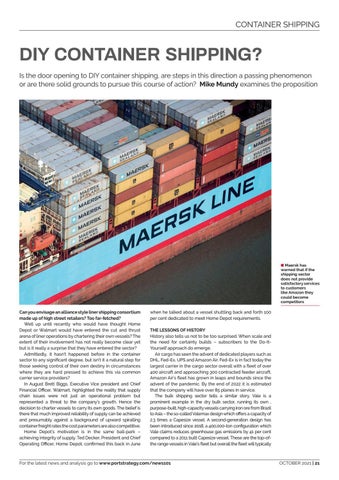CONTAINER SHIPPING
DIY CONTAINER SHIPPING? Is the door opening to DIY container shipping, are steps in this direction a passing phenomenon or are there solid grounds to pursue this course of action? Mike Mundy examines the proposition
8 Maersk has warned that if the shipping sector does not provide satisfactory services to customers like Amazon they could become competitors
Can you envisage an alliance style liner shipping consortium made up of high street retailers? Too far-fetched? Well up until recently who would have thought Home Depot or Walmart would have entered the cut and thrust arena of liner operations by chartering their own vessels? The extent of their involvement has not really become clear yet but is it really a surprise that they have entered the sector? Admittedly, it hasn’t happened before in the container sector to any significant degree, but isn’t it a natural step for those seeking control of their own destiny in circumstances where they are hard pressed to achieve this via common carrier service providers? In August Brett Biggs, Executive Vice president and Chief Financial Officer, Walmart, highlighted the reality that supply chain issues were not just an operational problem but represented a threat to the company’s growth. Hence the decision to charter vessels to carry its own goods. The belief is there that much improved reliability of supply can be achieved and presumably against a background of upward spiralling container freight rates the cost parameters are also competitive. Home Depot’s motivation is in the same ball-park – achieving integrity of supply. Ted Decker, President and Chief Operating Officer, Home Depot, confirmed this back in June
when he talked about a vessel shuttling back and forth 100 per cent dedicated to meet Home Depot requirements. THE LESSONS OF HISTORY History also tells us not to be too surprised. When scale and the need for certainty builds – subscribers to the Do-ItYourself approach do emerge. Air cargo has seen the advent of dedicated players such as DHL, Fed-Ex, UPS and Amazon Air. Fed-Ex is in fact today the largest carrier in the cargo sector overall with a fleet of over 400 aircraft and approaching 300 contracted feeder aircraft. Amazon Air’s fleet has grown in leaps and bounds since the advent of the pandemic. By the end of 2022 it is estimated that the company will have over 85 planes in service. The bulk shipping sector tells a similar story. Vale is a prominent example in the dry bulk sector, running its own , purpose-built, high-capacity vessels carrying iron ore from Brazil to Asia – the so-called Valemax design which offers a capacity of 2.3 times a Capesize vessel. A second-generation design has been introduced since 2018, a 400,000-ton configuration which Vale claims reduces greenhouse gas emissions by 41 per cent compared to a 2011 built Capesize vessel. These are the top-ofthe range vessels in Vale’s fleet but overall the fleet will typically
For the latest news and analysis go to www.portstrategy.com/news101
OCTOBER 2021 | 21











